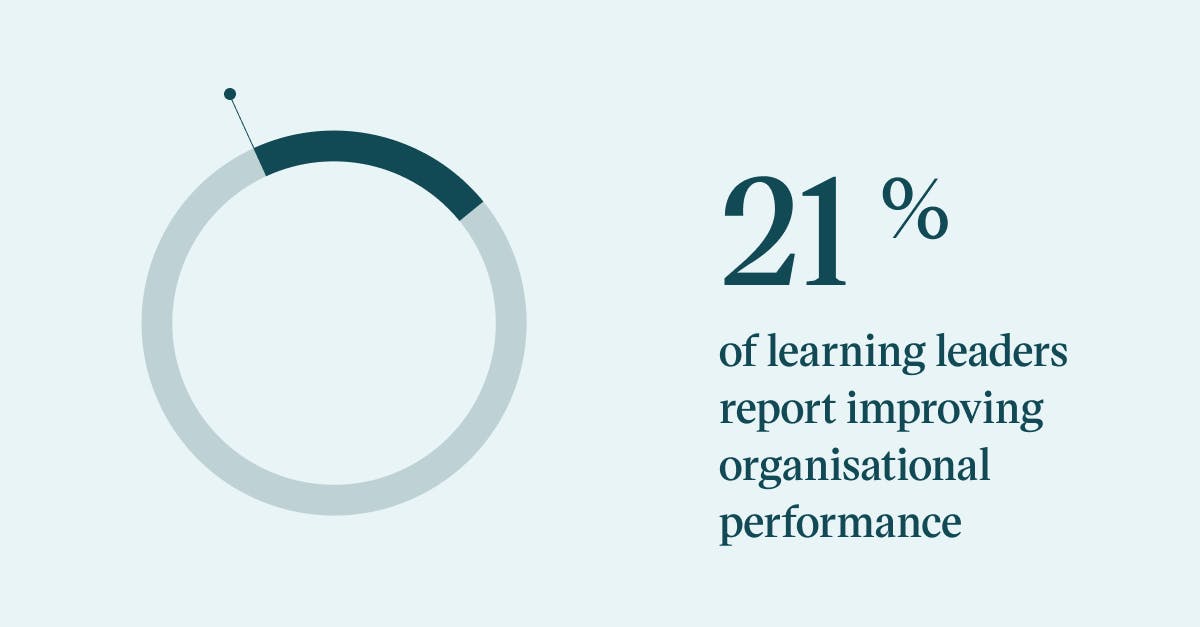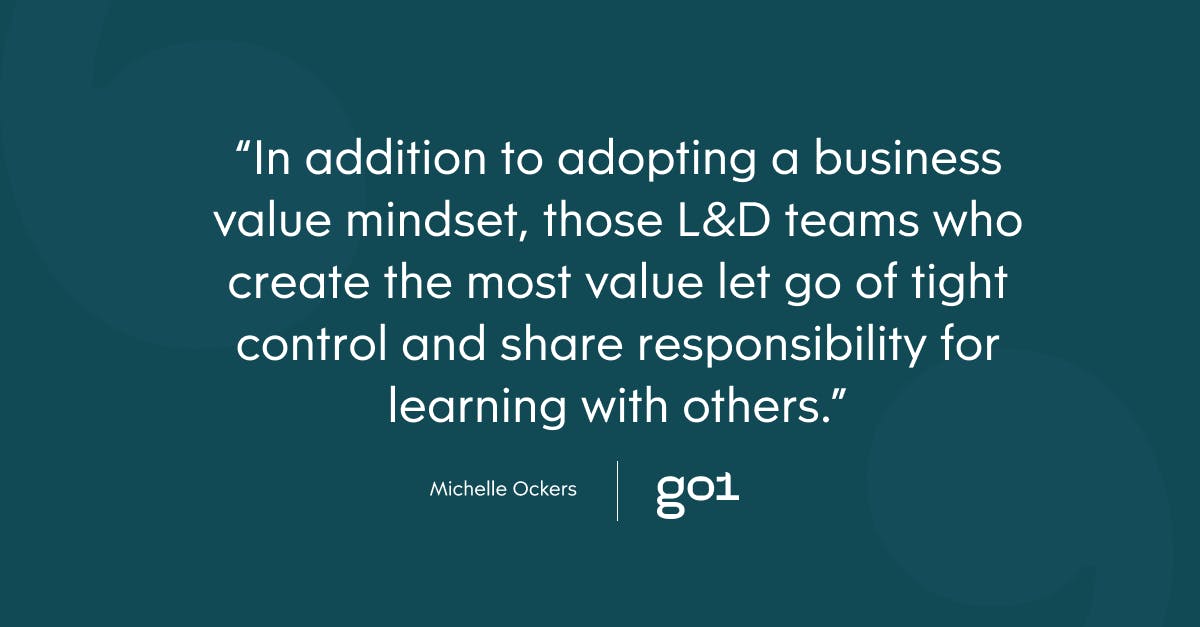
Crafting a digital learning strategy that creates value

Written by guest blogger Michelle Ockers, Learning Strategy Expert and host of the ‘Learning Uncut’ podcast. Michelle helps build future-ready learning organisations. She is a leading contemporary learning practitioner at the forefront of modernising learning and keeping the profession relevant and impactful in organisations.
The digital learning conundrum
How is it that despite L&D's long-standing fascination with learning technology, 49% of learning was still being delivered face-to-face in classrooms at the start of 2020? Benchmarking shows that in the ten years to 2020, the number of digital learning tools used in organisations more than doubled from an average of 10 to 25.
L&D is clearly curious about technology. And there’s plenty of it to be curious about!
The market is booming with new providers and tools. Even before Covid hit, 50% of organisations were expecting to increase their investment in learning systems during 2020.
However, this investment in technology is not translating to higher organisational impact. Benchmarking consistently shows that learning leaders have high aspirations yet make limited progress to achieve them. According to Emerald Works, at the start of 2020 only:
- 25% of learning leaders report impacting productivity
- 21% of learning leaders report improving organisational performance
- 18% of learning leaders have helped provide a faster response to changing business conditions

This is a perplexing conundrum! In a nutshell, despite increasing investment in learning technology:
- high levels of face-to-face training persist until we are forced to make a shift, and
- L&D continues to struggle to create value
One significant reason for this is that L&D has focussed on the wrong kind of value – learning value rather than business value. Laura Overton recently provided a compelling argument for why business value is L&D’s bedrock of digital success and the need to shift mindset in order to build stronger digital foundations.
Further insight can be gained by looking at how L&D teams responded to the pandemic.
2020: the swing to digital content and classrooms
The fierce urgency of the moment created by the pandemic demanded that L&D professionals adopt digital learning approaches. A study in May 2020 found that 94% of L&D teams had to change their strategy in response to COVID, with two in three teams making significant changes to what they do and how they do it.
There was a big push was to digital content. For example, National Australia Bank saw consumption on their third-party content platform explode from 15,000 hours per year to 9,000 hours per month. Another big shift was the move from physical to virtual classrooms.
In this early period, L&D decisions were driven by expediency. As Dani Johnson, RedThread Research co-founder, put it, “All of the rules changed, and organisations needed to very quickly get their people up to speed on something that resembled sameness.” For many, that ‘sameness’ meant that content and classrooms were their immediate response. It was all that they were equipped to support. However, while content is essential to support learning and performance, more is required to change behaviour and create business value.
What limits digital learning strategy?
While acknowledging that organisational policies and technology infrastructure are often a barrier, the key hurdles lie within L&D. This is good news as it means we can do something to make a change.
L&D team skill levels as reported by learning leaders at the start of 2020 include only:
- 32% have adequate technology/infrastructure skills, compared to 40% in early 2018
- 32% have adequate skill with virtual classroom/webinar delivery
- 29% have adequate digital content development skills

In part, these gaps reflect the challenge of staying abreast of the accelerating pace of change in technology and shifts in expectations placed upon L&D.
More fundamentally, the L&D mindset gets in the way. Key shifts needed to break through the digital learning conundrum are shown in the figure below. Specifically, fear that technology will make L&D redundant rather than augmenting what they do and allowing them to create more value. In addition to adopting a business value mindset, those L&D teams who create the most value let go of tight control and share responsibility for learning with others. They see others as connected contributors to learning rather than passive recipients of content and training. This shift engenders the curiosity to use technology to do things differently, rather than just doing things more efficiently.

Lessons from L&D’s digital leaders
We can learn a lot from those L&D teams that had already changed how they viewed their role and put in a sustained effort to build their digital capability over a number of years. For these teams, the adjustment required to support their organisations to adapt to COVID was more about the volume of work and focus, rather than about how they support learning. Examples include:
- Deciem, a small globally distributed beauty product manufacturer, focused on engagement and co-creation using their LXP as a hub for content, communication and community;
- Reece, a plumbing retailer in Australia and New Zealand, developed a completely peer-group facilitated leadership program with content just 25% of the digitally enabled learning approaches used; and
- The sales enablement team at GSK pharmaceuticals in India used a gamified digital approach to engage teams in challenges that built skills for new virtual sales channels.
Additionally, we can draw upon two robust bodies of research about learning innovation and technology: 16 years of L&D benchmarking from Emerald Works as well as the 2019 learning technology ecosystem report from RedThread:
Lesson 1 – Think Differently
Reimagine how you create value as an L&D professional. There is much higher leverage in enabling continuous learning through shared responsibility rather than L&D controlling learning. Be aware that your current technology may be creating blind spots, so put it aside as you seek to look beyond content and classrooms to innovate. Take it a step further to unshackle your mind and drop the assumption that all learning activity needs to be tracked.
"I realised that you can create such a blended, flexible, co-created strategy that reinvents what a learning moment is and when and how people learn. It's been transformational. It's hard to see that if your technology doesn't serve you the right way." – Kristina Tsiriotakis, Deciem.
Lesson 2 - Think strategically
Define the value proposition for learning in your organisation for all of your ‘customers’ – senior leaders, managers and the broader workforce. Ensure you have a documented strategy co-created with all stakeholders that describes the organisation’s vision for learning and how this will be achieved. Digital is just one pillar in a well-rounded learning strategy that is aligned to your organisational strategy and culture.

Lesson 3 – Think user first
Adopting a human-centred design approach means starting with the user experience, and then considering the technology that will best create this experience. This is just as relevant for the design of your overall technology suite as it is for specific learning solutions. Find out what technology people in your organisation use for work, learning, and social connection, as well as why and how they use it. Use these insights to inform your technology roadmap. Additionally, ensure that you consider all relevant use cases. Consuming content is just one of 11 learning technology functionalities that organisations use to develop their employees. Others include experimenting, connecting and performing – as well as administrative functions performed by L&D.
"Our lens is not the technology. Our lens is the experience we want to deliver. What we consider very deeply through our human-centred design process is “What is the ideal experience or the best experience that we may be able to deliver to affect learning transfer? And to really enable and support our people in this experience?” – Gareth Killeen, Reece
Lesson 4 – Think ‘I can become capable and confident’
The skills required to craft a digital learning strategy include technology management, digital design and delivery, organisational learning strategy and human-centred design. Every member of your L&D team needs a broad understanding of the contemporary technology landscape, plus proficiency with the tools relevant to their role. Larger L&D teams often have specialist roles to manage learning technology and lead technology-enabled innovation. Regardless of whether such roles are in place, create an environment where all L&D team members are able to keep themselves up to date, experiment, and share new ideas and practices with one another.
Business value mindset: Critical to successful digital learning strategy
Something fundamental needs to shift if L&D is to break through the pattern of ‘sameness’ and low levels of organisational impact despite high investment in technology. Breaking the digital learning conundrum requires different thinking. A shift in the L&D mindset is a critical first step to crafting a digital learning strategy that creates business value.
3 tips for crafting a digital learning strategy that creates value
1. Start with strategy, not digital
- Approach your learning strategy with a business value mindset
- Define the value proposition for learning in your organisation
- Co-create a well-rounded learning strategy
2. Focus on user experience
- Describe the experience you want to deliver to support your learning strategy
- Research how your people use technology for work, learning and social connection
- Define learning technology use cases
3. Get the technology into perspective
- Technology is an enabler of learning and performance, not the saviour
- Learning is a responsibility shared by people, not outsourced to technology
- Technology augments L&D people rather than replacing them
For more insights, be sure to subscribe to the Go1 newsletter to stay on top of all the latest L&D trends. Or, you can book a demo today to find out how Go1 can help with your team’s learning needs.




